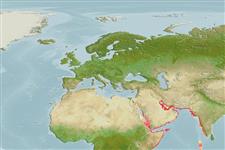>
Ovalentaria/misc (Various families in series Ovalentaria) >
Pseudochromidae (Dottybacks) > Pseudochrominae
Etymology: Pseudochromis: Greek, pseudes = false + Greek, chromis = a fish, perhaps a perch (Ref. 45335).
Eponymy: Linda J McCarthy (d: 1952) is an ichthyologist. [...] (Ref. 128868), visit book page.
More on authors: Randall & Stanaland.
Environment: milieu / climate zone / depth range / distribution range
पारिस्थितिकी
समुद्री ड़िमरसल; गहराई सीमा 1 - 20 m (Ref. 68964). Tropical
Western Indian Ocean: Gulf of Aden and southeastern Arabian Peninsula, and from the Persian Gulf east to Pakistan.
आकार / वज़न / Age
Maturity: Lm ? range ? - ? cm
Max length : 8.1 cm TL पुल्लिंग / अलिंग; (Ref. 11441)
Collected from tidal pools and coral and rock reefs; associated with live and dead branching corals (e.g. Acropora and Pocillopora) (Ref. 12720).
Life cycle and mating behavior
परिपक्व अवधि | पुनरुत्पत्ति | मछलीऔ का अंडे देना | अंडे | Fecundity | लार्वा
Gill, A.C. and J.K.L. Mee, 1993. Notes on dottyback fishes of the genus Pseudochromis of Oman, with description of a new species (Perciformes: Pseudochromidae). Rev. Fr. Aquariol. 20(2):53-60. (Ref. 12720)
IUCN Red List Status (Ref. 130435: Version 2024-2)
Threat to humans
Harmless
Human uses
साधन
Special reports
Download XML
इंटरनेट स्रोत
Estimates based on models
Preferred temperature (Ref.
123201): 26.4 - 29.2, mean 27.6 °C (based on 436 cells).
Phylogenetic diversity index (Ref.
82804): PD
50 = 0.5000 [Uniqueness, from 0.5 = low to 2.0 = high].
Bayesian length-weight: a=0.01148 (0.00474 - 0.02781), b=2.95 (2.74 - 3.16), in cm total length, based on LWR estimates for this (Sub)family-body shape (Ref.
93245).
Trophic level (Ref.
69278): 3.5 ±0.5 se; based on size and trophs of closest relatives
Fishing Vulnerability (Ref.
59153): Low vulnerability (10 of 100).
